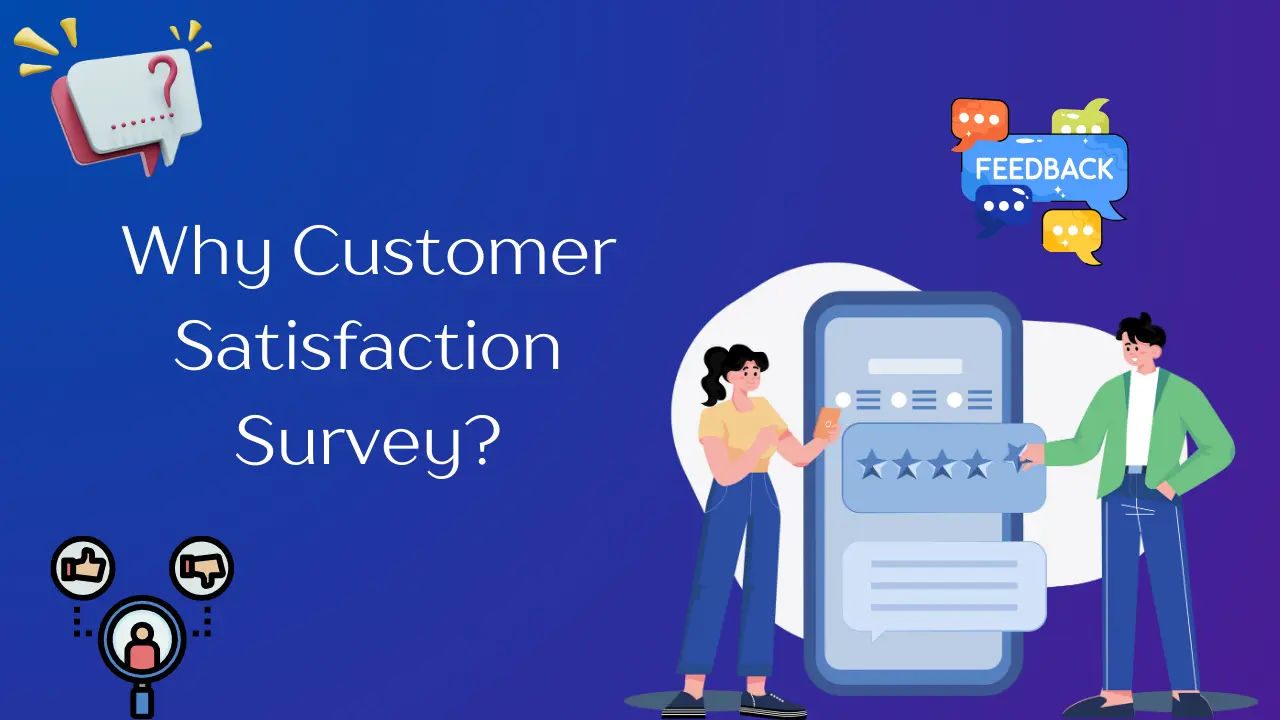Companies often fall into the trap of making assumptions about their products and services, sometimes overestimating how satisfied their customers truly are. However, the fundamental truth remains: no one understands customer satisfaction better than the customer themselves.
In today’s competitive market, customer satisfaction is the key factor that can give businesses a decisive edge. It not only provides insights into how well your products and services are performing but also emphasizes delivering an exceptional customer experience.
This focus on customer experience is so crucial that, according to data from Zonka, American Express found that consumers are willing to spend 17% more on a company that provides outstanding customer service.
This is where the customer satisfaction survey, often perceived as a routine feedback tool, reveals its true power. It is not just used as a metric, but as a dialogue between a brand and its customers – that has the potential to redefine relationships between a brand and its audience.
In this blog, we’ll explore the deeper purpose of customer satisfaction surveys to gain fresh perspective, through examples, some tips, and benefits. We will also see how you can create a customer survey using the WordPress survey plugin.
Table of Contents
Definition of Customer Satisfaction Survey
A customer satisfaction survey allows companies to measure satisfaction rates and understand customer sentiment toward products, services, and experiences.
It evaluates your ability to meet the customers’ expectations and provide them with a positive experience.

A great customer experience can result in increased sales and higher customer loyalty. If you focus on excellent customer service and meeting expectations, customers will likely appreciate your brand and remain loyal to it – something strongly suggested by customer satisfaction stats from Zonka.
Customer surveys are designed to gather feedback that gives insights into audience demographics, customer preferences, behavioural trends, and the effectiveness of your solutions.
These marketing research surveys can be conducted through chatbots, emails, pop-ups, and site surveys.
Key Metrics to Measure Customer Surveys
There are different ways to measure customer satisfaction. Here are listed few of them;
1. Customer Satisfaction Score
A fundamental and leading metric to measure customer loyalty is the Customer Satisfaction Score [CSAT]. It directly measures customers’ overall experience with your brand’s product or service.
This marketing research survey asks customers to rate their satisfaction and experience on a 5 or 7-point scale.
For example, a customer purchases a new device from an online store and receives it, the customer might be asked to complete a short survey via email to gauge their satisfaction with the experience.
A typical CSAT Survey Question could be – On a scale of 1 to 5, how satisfied are you with your recent purchase experience?
- 1 – Extremely Dissatisfied
- 2 – Dissatisfied
- 3 – Neutral
- 4 – Satisfied
- 5 – Extremely Satisfied
To calculate the CSAT score, -divided the number of customers who rated their experience as either satisfied or extremely satisfied [4 or 5] by the total number of responses, then multiply by 100.
CSAT = (Total number of responses ÷ Number of satisfied customers) × 100
This will give you the percentage score of customers who were satisfied with their purchase experience.
The feedback you receive can help you improve customer satisfaction and experience.
2. Net Promoter Score
Net Promoter Score [NPS] is another popular metric that many businesses rely on to measure customer satisfaction, loyalty, and experience.
It measures how satisfied customers are with your company by asking – “How likely are you going to recommend our company products or services to a friend/colleague?”
Customers respond on a 0-10 scale, reflecting their overall experience with your brand.
This metric can help you achieve quantitative and qualitative data, especially when you include follow-up questions like –
- What is the primary reason for your score?
- How can we improve your experience?
By analyzing the average NPS, you can reflect on the effect of your business and prioritize areas for improvement and growth.
3. Customer Effort Score
Customer Effort Score [CES] is a metric derived from customer satisfaction surveys. It measures the ease with which customers use your product or service.
CES reflects the amount of effort a customer must exert to use a product/service, fulfill a request, or resolve an issue. It specifically targets customer loyalty.
In this market research survey, customers rate how easy it was to resolve their issue, typically on a scale ranging from “not easy at all” (1 point) to “very easy” (5 or 7 points).
The average score indicates the level of effort customers experience when interacting with your brand.
4. Customer Retention Rate
Customers are more likely to switch brands if they aren’t satisfied with your products, services, or experiences. According to SurveySparrow research, customer retention rates increase by 5% for every 1% increase in customer satisfaction.
An efficient way to measure customer satisfaction is by measuring the customer retention rate.
This metric indicates the rate at which customers continue to do business with your brand over a period of time. It serves as an indicator of their satisfaction with the services you provide.
A high customer retention rate suggests that your customers are satisfied and willing to be loyal to your brand.
The Importance of Customer Surveys

Customer satisfaction surveys help you understand the customer experience, providing a reality check on which products, services, or experiences are working for the customer and which are not.
It gives your company data insights to create a positive, refined, and valuable customer experience. They highlight the pain points so you can address those areas and prevent customer churn.
If your customer experience is poor, it negatively impacts your business. In fact, 78% of customers have backed out of purchase due to a poor experience.
Conversely, a positive customer experience is one of the most determining factors in winning customers and building loyalty. By understanding the elements that contribute to high customer satisfaction, you can create better experiences for your customers.
Customer site surveys also provide valuable data on customer preferences, how they interact with your business, and what keeps them loyal.
Analyzing such data helps you stay ahead of consumer trends and familiarizes you with patterns, evolving customer behaviours, and your ideal customer persona.
Types of Customer Satisfaction Survey Question Types
Gathering useful information through marketing research surveys hinges on asking the right type of questions. Although there are only a few fundamental question types, choosing the appropriate one can make all the difference in the quality of the insights you gather.
Let’s look into different question types that can effectively measure customer satisfaction.
Likert scale
The Likert scale is a standard survey question that offers more flexibility than simple yes/no questions.
This scale measures customers’ level of agreement and likelihood, usually across 5 to 7 responses, ranging from ‘Strongly Agree’ to ‘Strongly Disagree,” or in the case of frequency, the scale is – “Never, Rarely, Sometimes, Often, Frequently.”
Businesses can use Likert scale questions to assess customer sentiments across various aspects, including satisfaction, frequency, and overall desirability of their brand, products, or services.
Here are some examples of Likert scale questions for customer satisfaction surveys;
- How satisfied are you with the overall quality of our product/service?
- How likely are you to recommend our company to a friend or colleague?
- How well did our customer service team address your concerns?
Open-ended questions
In contrast to close-ended questions like the Likert scale or MCQs, open-ended questions provide rich qualitative data. These questions allow for deeper insights, uncovering the reasons and motivations behind customers’ responses.
Using open-ended questions in site surveys helps you connect with your customer’s opinions for valuable insights and uncover new ideas.
This approach also shows customers that their feedback is valued and prioritized. The flexibility of this question type can yield detailed information for your company.
Here are certain types of open-ended questions that businesses add in their surveys to know in detail about customers’ opinions;
- What did you like most about your experience with our product/service?
- What can we do to improve your experience with our company?
- Can you describe any challenges or issues you faced while using our website?
Binary Questions
As the name suggests, this type of question relies on a limit of two options per question, such as a Yes/No or True/False.
These can also be presented with visual cues, like happy/sad faces or thumbs up/thumbs down, which have become increasingly popular among businesses.
Here are some examples of Binary scale questions;
- Were you satisfied with the speed of your order delivery? (Yes/No)
- Did you find our website easy to navigate? (Yes/No)
Ranking Questions
Ranking questions ask customers to rank options or attributes based on their preferences, satisfaction, or likelihood of recommendation.
This helps companies identify what customers prioritize and where improvements are needed.
- Rank the following aspects of our customer service from most to least satisfying:
- Please rank the following features of our product in order of importance to you:
- How would you rank these communication methods for receiving updates from us, from most preferred to least preferred?
How to Create a Customer Satisfaction Survey
When designing a customer satisfaction survey, it’s essential to consider your survey’s objective. Several customer satisfaction survey questions can help you understand many aspects of your customer journey as well as your brand in the market.

For example, ask questions to understand product/service quality and get product quality feedback.
- How satisfied are you with the quality of the product/service you received?
- Did the product/service meet your expectations in terms of performance?
Similarly, you can ask questions to understand the post-purchase experience of customers;
- How satisfied were you with the delivery time of your recent purchase?
- Was the product you received exactly as described on our website?
The key to creating a useful customer survey is to start with a goal in mind. The objective of your satisfaction survey will help you with the type of questions you select.
Aside from that, there are other points to keep in mind when designing a survey for better engagement.
- Keep your survey short and concise – To ensure higher engagement, make your survey easy to complete. A shorter survey respects your customers’ time and increases the likelihood of participation.
- Choose the right delivery method and time – The success of your survey depends on how and when you deliver it. For instance, sending a feedback survey via SMS immediately after a purchase can capture timely insights.
- Create a logical question flow – When creating a survey, organize your survey in a logical question sequence to make it easy for customers to follow.
For instance, group questions about pricing satisfaction together to help customers provide more focused feedback.
- Act on feedback – The ultimate purpose of a customer satisfaction survey is to gain insights and take action. Use the feedback to make improvements and show customers that their input has a real impact on your business.
Design Customer Satisfaction with the Right Survey Tool
Creating an effective customer satisfaction survey also requires choosing the right survey tool or a WordPress survey plugin that helps you implement your ideas easily.
Quiz and Survey Master (QSM) is a reliable WordPress survey plugin that facilitates the creation of customer surveys with various question types. It supports multiple formats, including Likert scales, multiple-choice, and open-ended questions, making it versatile for gathering comprehensive feedback.
The plugin also offers customization options, enabling you to tailor the survey to match your brand’s look and feel, ensuring a seamless experience for respondents.
Additionally, QSM provides a Reporting and Analytics add-on that allows you to analyze survey results efficiently, helping you derive actionable insights from the feedback collected.
If you want to know how you can create a customer satisfaction survey using QSM, then go through this article – How to Create a Customer Satisfaction Survey in WordPress?




